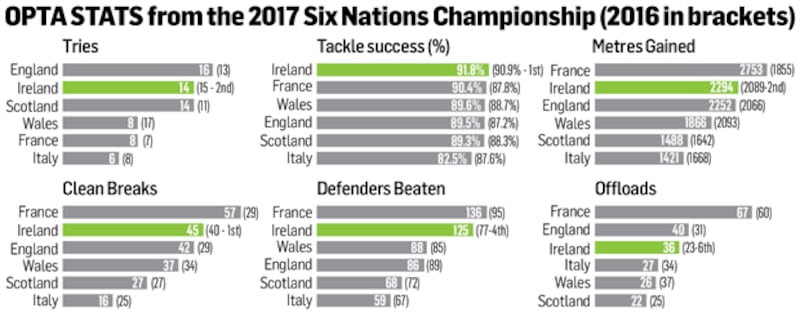In delving one final time into the statistics relating to Ireland's performance in the 2017 Six Nations Championship, this column thought it germane to compare them across a number of categories to the corresponding numbers accumulated in the previous year's tournament.
In the 2016 Six Nations, Joe Schmidt’s Ireland finished third, winning two and losing two matches while drawing against Wales. This season they won three games and lost two in finishing runners-up behind England.
Focusing initially on the general theme, the Irish team scored two points fewer this season (126 against 128) and conceded 10 fewer (77 against 87) but it is across the categories listed in the graphic that drills down a little deeper into the effectiveness of their general performances.

Arguably the most striking figure is the increase in the number of offloads by Irish players in this season’s tournament. There were 13 more offloads in 2017 and of more import is that Ireland went from the team with the least in last year’s tournament, to third place, four adrift of England but trailing France by a whopping 31.
Whereas France, Ireland and England increased their offload tallies, Italy, Wales and Scotland’s numbers suffered an appreciable dip. It an attacking capacity, the Irish team managed one fewer try, 14, than they did the previous season but were up in terms defenders beaten.
Clean breaks
In that category, Ireland went from fourth place and 77 defenders beaten across the five matches, to second (125) behind Guy Novès’ France team. In ‘clean breaks’ Ireland dropped from first place (40) in the 2016 tournament to second this year, despite making five more.
So parsing the statistics from an attacking perspective, Schmidt’s side have improved across a variety of benchmarks. They also improved in a fourth category as they increased the number of metres gained across the tournament by 205 and so retained their second place in the standings.
As an aside, the team that made the most startling gains were France, supporting the assertion that this season under Novès they have made real progress in restoring some of their old attacking traditions and values.
Considering the loss of the outstanding attacking fulcrum centre Wesley Fofana, they have made notable strides in performance terms.
So what about the other side of the ledger for Ireland? Defence. In the 2016 Six Nations, Ireland conceded nine tries across the five matches; this season that figure was down to seven.
Bizarre
Three of those came across Scotland in a disappointing opening 20-minute spell, including a bizarre concession from a lineout fielded by Scottish centre Alan Dunbar. It was clever play but not one that would have pleased the Ireland defence coach Andy Farrell.
Ireland also conceded three tries to Wales, while the other was a penalty try in the victory over Italy in Rome. As the graph indicates, Ireland retained their pre-eminence at the top of the standings in terms of tackle success and that included nudging the percentage of good tackles higher into the 90s. Only Italy took a backward step.
So in bare numbers, Ireland improved their stats across five of the six categories listed. Schmidt will be looking to consolidate that upward trend when the squad travel to play three Test matches in the summer, two in Japan and one against the USA.















